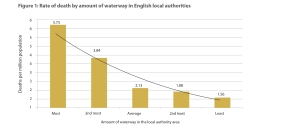Consultation: Draft Open Water Swimming advice from the National Water Safety Forum
Analysis based on the NWSF Water Incident Database (WAID) accident data from 2009-11; shows an average of 19 fatalities per year at inland-open-water sites (lakes, rivers, pools, quarries, canals) occurred in circumstances that could be attributed to open water swimming. The risks of in-water death is approximately 1:200,000 participants per year; similar to that of a pedestrian being struck by a motor vehicle[i].
This document has been developed by members of the watersports and inland advisory groups. It is intended to cover key points for members of the public, who wish to swim in open water.
The base information (10 points) will be used as a framework by members in response to queries. The final version will sit on the NWSF website, with links to further information and advice from members and stakeholders.
There are a number of specific elements we would like your view on:
– Have we missed any critical safety points?
– Is the length and tone correct?
– Have we used too much by way of technical language?
– Is it easy to read?
– What extra background or wider information should we cite and direct people to?
Please include if your response is on behalf of a group or organisation, or as an individual.
We would like your views on the above and other points you wish to raise, by Friday 26th July. You can respond to: info@nationalwatersafety.org.uk
Draft for comment, July 13
Open water swimming advice
Introduction
Variously termed ‘wild’ and open water swimming, this activity is not new but is enjoying something of a revival in the UK. Open water can be used to describe, rivers, lakes, pools and the sea. Any recreational use of water should be encouraged but equally it is important to enjoy the activity safely.
Analysis based on NWSF-WAID accident data (2009-11) shows an average of 19 fatalities per year at inland-open-water sites (lakes, rivers ect) occurred in circumstances that could be attributed to open water swimming. The risks of in-water death is approximately 1:200,000 participants per year, similar to that of a pedestrian being struck by a motor vehicle[i].
These guidelines are intended to provide simple common sense points to help you enjoy safer swimming in open water. However, it should be recognised that there are significant differences between a swimming pool and open water swimming and swimmers are recommended to seek an introduction with an experienced leader to develop awareness, competency and confidence in open water.
Our top A-B-C tips for safe open water swimming:
Activity
1. If you want to drink alcohol do it after swimming not before
2. Go with a group – you’ll have help on hand
3. Swim in known locations and before entering the water make sure there is a safe exit point
• Check out local knowledge and advice (speak to clubs)
• Look out for and follow any safety signage
• Avoid weirs, locks and other structures
• Swim parallel to the shore not into deep water and within your personal limits
• Avoid swimming in polluted waters (e.g. sewage, blue/green algae, farm runoff).
Buoyancy
1. Cold water can sap body heat very quickly so wear suitable thermal protection (a wetsuit will also provide some additional buoyancy)
2. Only swim if you are confident in your ability in the water and wear additional buoyancy if you are not a strong swimmer. Other clothing to consider
• Footwear for protection and grip when entering and exiting the water
• Googles, to protect eyes but also allow you to see underwater for obstructions etc.
• Headwear, especially a high visibility swim cap in areas with lots of surface traffic.
Conditions
1. When entering the water be aware of the effects of cold shock and ensure you acclimatise before swimming in deeper water
2. Limit exposure (20 mins or start to shiver) and take account of surface conditions
3. Keep warm before swimming and have the means to warm up immediately after a swim
4. Know how to cope with cramp (stay shallow so you can stand up or use extra buoyancy)
5. Make sure you have the means of alerting the emergency services
________________________________________
[i] http://www.rospa.com/leisuresafety/Info/Watersafety/inland-waters-risk-assessment.pdf






You must be logged in to post a comment.